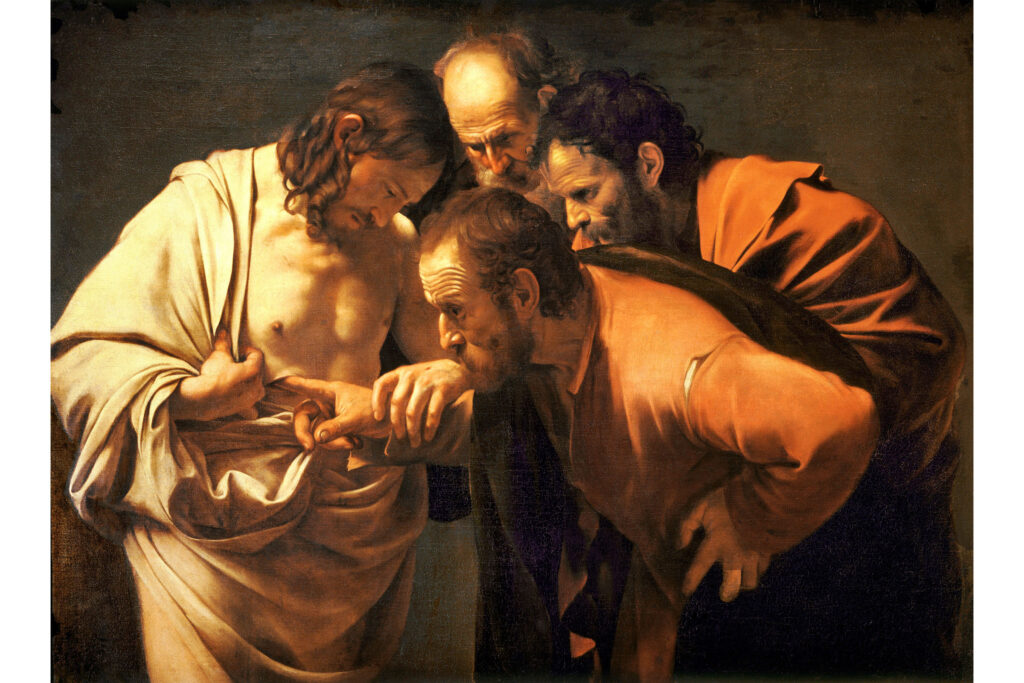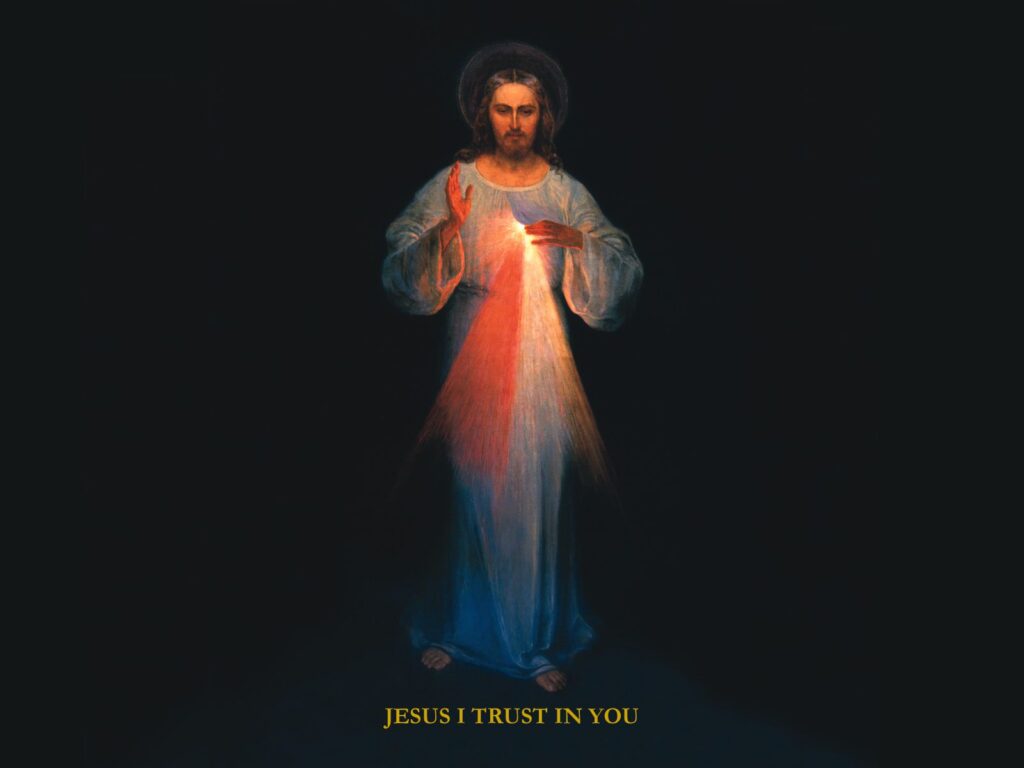
St. Thomas and Us: A twinship
Caravaggio’s magnificent painting of The Incredulity of St Thomas graphically details a story we’re very familiar with. Jesus’ appearance to the frightened apostles through the locked door to the room they hid in, occurs just days after the horror of the Crucifixion. The Lord comes to satisfy St. Thomas’s strident incredulity and breathe the Spirit upon each of the apostles. St. Thomas and Us: A twinship
Could it be that we’re too familiar with this story? And with Thomas’s stidence?
St. Thomas the Apostle has a modifier: the twin. John the Evangelist mentions it three times. The repeat makes us wonder, doesn’t it? Consistently we refer to Thomas as ‘the doubter,’ even using it as an adjective for a skeptic—doubting Thomas.
But could Didymus mean something other than a twin sibling?
Like a description for a dual nature?
One that both doubts and believes?
Like us who say we believe but frequently reveal our lack of belief? St. Thomas and us: a twinship of doubters and believers.
The Gospel for the second Sunday of Easter is very long, with a density that seems to infuse each stanza. I’ve embedded it here in case you want to reread the entire passage.
Here’s the Lord’s reply to doubting Thomas:
Then he said to Thomas, “Put your finger here and see my hands, and bring your hand and put it into my side,and do not be unbelieving, but believe.”
Thomas answered and said to him, “My Lord and my God!” Jesus said to him,
“Have you come to believe because you have seen me? Blessed are those who have not seen and have believed.”
With that statement, “blessed are those who have not seen and have believed” is Jesus referring to us?
There’s virtue in doubting
claims Fr.William Nicholas in an an intruiging homily offered during the Covid pandemic. Listening to this priest’s ten-minute sermon brought me back to those shocking days when churches were closed all over the world. When I and just about everyone I knew, believed that God was allowing this. That it was just chastisement for sin. I recall too, the blessing of our introduction to the priests on EWTN and their daily Mass.
Fr. Nicholas’s reflection reveals a very diffent way to think about this apostle-about the entire subjects of doubt and belief.
It was Thomas, upon hearing that Jesus was going to Jerusalem to awaken Lazarus, who said to the rest of the disciples, “Let us go with him that we may die with him.”
And it was Thomas who established several churches in southern India where Syriac- a dialect of Aramaic spoken by Christ and the apostles is still spoken. And then was stabbed to death in Mylapore, India.
So how did the man so strident about his unbelief so completely change?
Maybe his transformation was no different from that of all the apostles—and you and me: a twinship of doubters and believers.
This week’s daily liturgy reveals St. Peter’s about-face from his triple denial of the Lord to steadfast refusal to comply with the Jewish authorityies. Standing before the fearsome Sanhedrin for his continued preaching about “this Jesus”, Peter declares, “We must obey God rather than men.”
With ease I can recall one of my very first confessions following my conversion to Catholic Christianity. Patiently the priest listened as I sobbed through my litany of sins. Still overwhelmed with the horror of life before, I could not stop. Finally, when the sobs had reduced to quiet tears, the priest said simply, “The Apostles lived and worked with Jesus for three years. Until they were filled with the Spirit, they were afraid, weak and ignorant.”
Unsaid, “Like you.”
Indeed.
And so I wonder, when I’m at adoration, do I “believe even though I don’t see?”
When I receive Him, am I thinking, “I believe even though I don’t see him?”
Back during those days of spiritual communion from EWTN daily Masses, was I believing despite not seeing?
No, I stare at that white wafer and know it’s—Him. Back then, I was fully confident that the Mass I watched and the spiritual communion I participated was Jesus: Faith.
But when something unexpected happens to me, my husband, loved one and/or the world, am I shaken?
And do I always see Him then?
No, then I can no longer see. St. Thomas and us: Both doubters. St. Thomas And Us: A Twinship of Doubters and Believers
During this Easter Season
of fifty days, I aim to make offering myself as I am right now, believer or doubter, to Him habitual. Hold on for just a moment and I’ll explain that perculiar comment.
A few years ago, I hesitantly blurted out my goal to my then spiritual director:
“Fr. Chris, I want to be a saint.” Since he neither doubled over in laughter nor looked incredulous, I then said, “There, I’ve finally said it, that wasn’t too painful.”
So the goal’s clear, what next?
I’ll bet you know the steps better than I so no need to repeat, it’s the work of daily life.
On the subject of that work, I picked up Fr. Michael Gaitley’s book, 33 Days to Merciful Love, at the beginning of Lent. And read it slowly and carefully. The priest begins with his personal experience while a seminarian. In hopes of impressing, Fr. Seraphim Michalenko, MIC, young seminarian Fr. Gaitley stated that holiness is all about consoling the Heart of Jesus. Pleased by the older priest’s {an expert on the Message of Divine Mercy] enthusiastic reply, the author declared that the best way is to “remove the thorn in His Sacred Heart that happens through our lack of trust.”
Now on a roll, he concluded, that
“it’s all about trusting Jesus in order to console him.”
But was stumped when his mentor asked,
“And how do you live trust? What’s the concrete expression in your daily living?”
I was stumped. “I don’t know.”
His answer changed my life: “The way you live trust is by praise and thanksgiving, to praise and thank God in all things. That’s what the Lord said to Sr. Faustina.”
Fr. Gaitley presents St. Therese of Lesieux’s Little Way of offering to Merciful Love
in a way that’s exciting, eminently practical and consoling. The young saint Therese knew that no amount of penance or prayer can cleanse our sinfuless: Our recourse is focusing on our nothingness. Precisely what Luisa Piccarreta, St. Faustina and Our Lady write.
We’ve one of two paths to choose in this life: His Justice or His Mercy. Although I’d read and written a bit about this saint, I’d not gotten the message I needed to know.
Can this be any clearer?
…For the sake of friendship, in Jesus Christ, the incarnate Son of God chose to need our love, because His heart experiences both joys and sorrows, we can enter into true friendship with him. So, he can share with us not only his joys but also his needs, sorrows and pains—and we can console him…
How?
We console him by loving, letting him love us and by allowing him to have mercy on us, save us. In fact, Jesus’ ‘need is to show mercy and to save us….When people reject his mercy, it causes him pain….That’s what St. John Paul ll marvels at when he askes, “Could man’s dignity be more highly respected and ennobled, for, in obtaining marcy, [man] is in a sense the one who at the same time shows mercy?’
“Ecce.”
“Fiat.”




